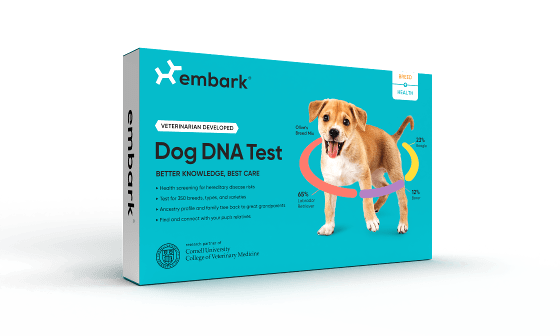Say cheese! Let’s discuss how to tell the age of a puppy based on their teeth. We’ll explain how veterinarians determine dog age using a teeth chart, how your puppy’s teeth can help you estimate their age, and how the science of DNA methylation offers a new way to estimate a dog’s age with remarkable accuracy.
Often, adopted dogs are a mixture of multiple breeds, so it’s hard to use breed or predicted body size to estimate their age (but you can use an Embark dog DNA test to find out their predicted adult weight and breed mix). Teeth are generally a reliable indicator of age, whether or not your dog is a rescue. Your dog will lose all baby teeth before they about 6 months old.
However, not all dogs follow this typical progression. Your vet is an expert in predicting dog age using a teeth chart and should be used as a resource. This is especially useful during the transitional time when your puppy is losing baby teeth and gaining adult teeth. After all of their adult teeth are in, it’s harder to determine an age range by studying their teeth.
Here is a summary of your dog’s teeth and when they erupt.
Baby teeth
- Deciduous incisors: The deciduous (baby) incisors will most likely erupt when your pup is 3-4 weeks old.
- Deciduous canines: The deciduous canines erupt next starting at 3-5 weeks of age.
- Deciduous premolars: Then the deciduous premolars will erupt at 4-6 weeks old. Puppies have three baby premolars on the top and bottom of both sides.
Learn more about deciduous teeth with this canine dental chart.
Adult teeth
- Permanent incisors: Permanent incisors typically start to come in when your dog is about 3 months old. In total there are three pairs of incisors per jaw, and the final pair usually comes in at 5 months old.
- Permanent canines: The adult canine teeth are visible starting at 4-6 months of age.
- Premolars: These are the teeth furthest back in your dog’s mouth before the adult molars erupt. Dogs lose their deciduous premolars, and four permanent premolars come in on the top and bottom of both sides. The permanent premolars come in between 4-6 months of age.
- Molars: Dogs do not have baby molars, but there are two permanent molars on each side of the top jaw (maxilla) and three permanent molars on each side of the bottom jaw (mandible). All molars will erupt by 4-7 months of age.
This adult canine dental chart shows the full range of permanent adult teeth.
If you’re interested in learning more about your pup’s teeth, the American College of Veterinary Dentists breaks down the types and names of canine teeth.
Older dogs
Vets use the amount of wear and tartar accumulation on your dog’s teeth to determine age when they are older. Dog teeth are typically less pointed after about 5-6 years of age. Your dog’s teeth will depend on their routine (how much they chew, what they chew, and food choice) and previous dental cleanings or at home care. That’s why age is harder to determine after puppyhood.
Why dog age matters
Knowing your puppy’s age can help inform what type of age-appropriate lifestyle and care are right for them. Learn more about how veterinarians estimate dog age and how to care for your dog through all life stages.
Curious about your dog’s age? The Embark Age Test uses the science of DNA methylation to estimate your dog’s age and birthday. It’s time to break out the party hats and celebrate your dog’s special day!








